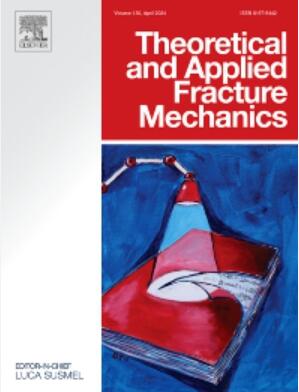声发射表征应变率对CFRP复合材料I型分层的影响
IF 5.6
2区 工程技术
Q1 ENGINEERING, MECHANICAL
引用次数: 0
摘要
应变率对碳纤维增强聚合物(CFRP)复合材料I型分层的影响一直是一个有争议的话题,传统的测试方法难以有效表征其在不同加载速率下的力学行为。本研究旨在利用声发射(AE)技术研究应变率对CFRP复合材料I型分层的影响。宏观力学和微观形貌分析表明,低加载速率下的层间破坏模式由纤维/基体脱粘和基体开裂转变为高加载速率下基体的层间脆性断裂。细观尺度声发射数据进一步揭示了I型分层加载速率对损伤源能量和活度的影响。此外,声发射峰值频率数据表明,加载速率的增加改变了分层过程中的损伤模式,从基体开裂转变为界面效应驱动的损伤。实验数据结合推导的半经验应变率效应模型,证实声发射能量加权质心频率与层间应变率效应呈正相关。这些发现表明,在本研究范围内,声发射技术是表征CFRP复合材料I型分层应变率效应的有效方法。本文章由计算机程序翻译,如有差异,请以英文原文为准。
Characterizing the strain rate effect on Mode I delamination of CFRP composites using acoustic emission
The strain rate effect on Mode I delamination in carbon-fiber-reinforced polymer (CFRP) composites remains a subject of significant debate, and conventional testing methods struggle to effectively characterize its mechanical behavior under different loading rates. This study aims to investigate the strain rate effect on Mode I delamination in CFRP composites using acoustic emission (AE) techniques. Macro-mechanical and microscopic morphology analyses indicate that the interlaminar failure mode shifts from fiber/matrix debonding and matrix cracking at lower loading rates to interlaminar brittle fracture of the matrix at higher loading rates. Meso-scale AE data further reveal the influence of Mode I delamination loading rate on damage source energy and activity. Additionally, AE peak frequency data suggest that an increase in loading rate alters the damage modes in the delamination process, shifting from matrix cracking to interfacial effect-driven damage. Furthermore, experimental data combined with a derived semi-empirical strain rate effect model confirm a positive correlation between AE energy-weighted centroid frequency and the interlaminar strain rate effect. These findings demonstrate that, within the scope of this study, AE technology is an effective approach for characterizing the strain rate effect on Mode I delamination in CFRP composites.
求助全文
通过发布文献求助,成功后即可免费获取论文全文。
去求助
来源期刊

Theoretical and Applied Fracture Mechanics
工程技术-工程:机械
CiteScore
8.40
自引率
18.90%
发文量
435
审稿时长
37 days
期刊介绍:
Theoretical and Applied Fracture Mechanics'' aims & scopes have been re-designed to cover both the theoretical, applied, and numerical aspects associated with those cracking related phenomena taking place, at a micro-, meso-, and macroscopic level, in materials/components/structures of any kind.
The journal aims to cover the cracking/mechanical behaviour of materials/components/structures in those situations involving both time-independent and time-dependent system of external forces/moments (such as, for instance, quasi-static, impulsive, impact, blasting, creep, contact, and fatigue loading). Since, under the above circumstances, the mechanical behaviour of cracked materials/components/structures is also affected by the environmental conditions, the journal would consider also those theoretical/experimental research works investigating the effect of external variables such as, for instance, the effect of corrosive environments as well as of high/low-temperature.
 求助内容:
求助内容: 应助结果提醒方式:
应助结果提醒方式:


